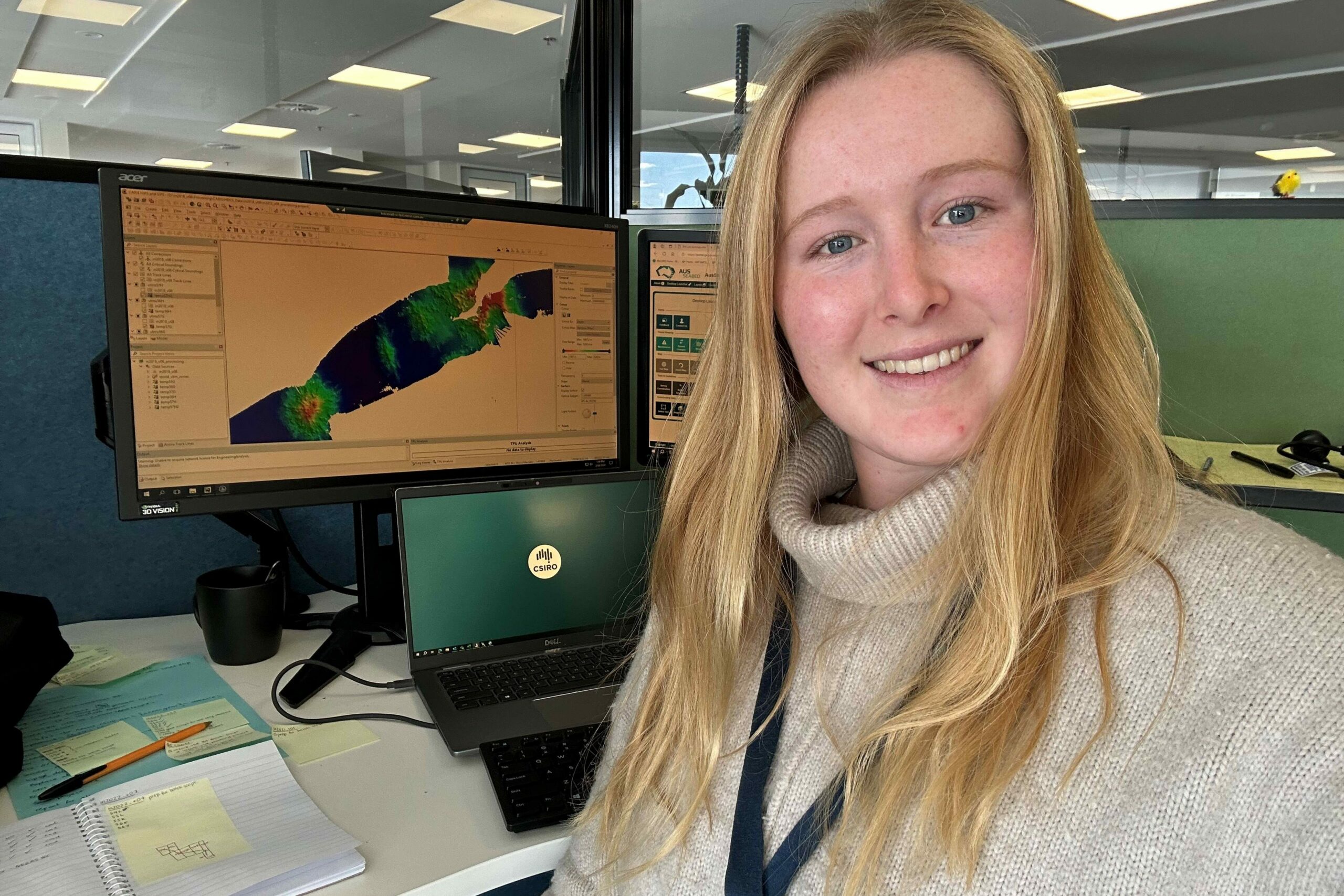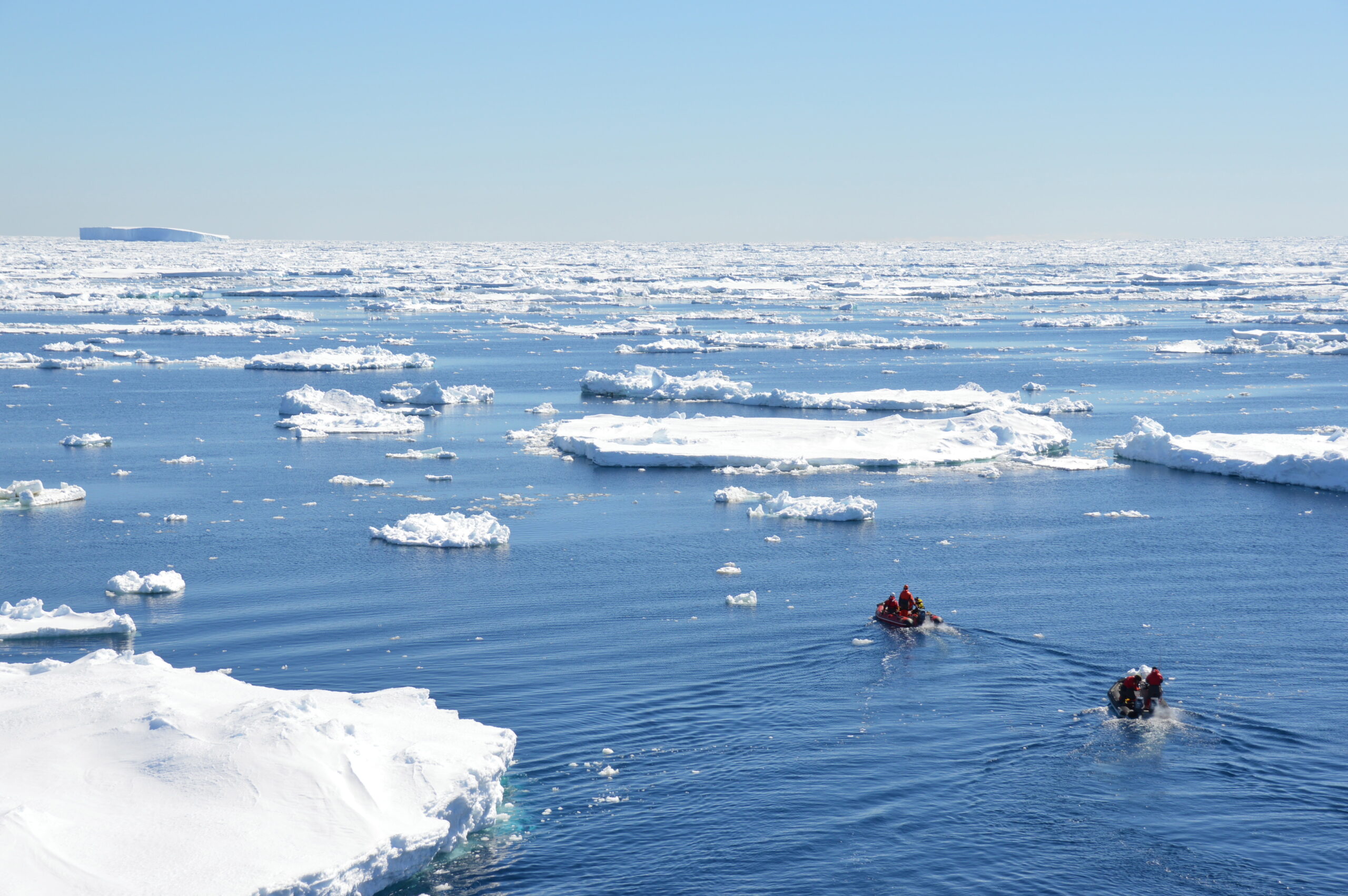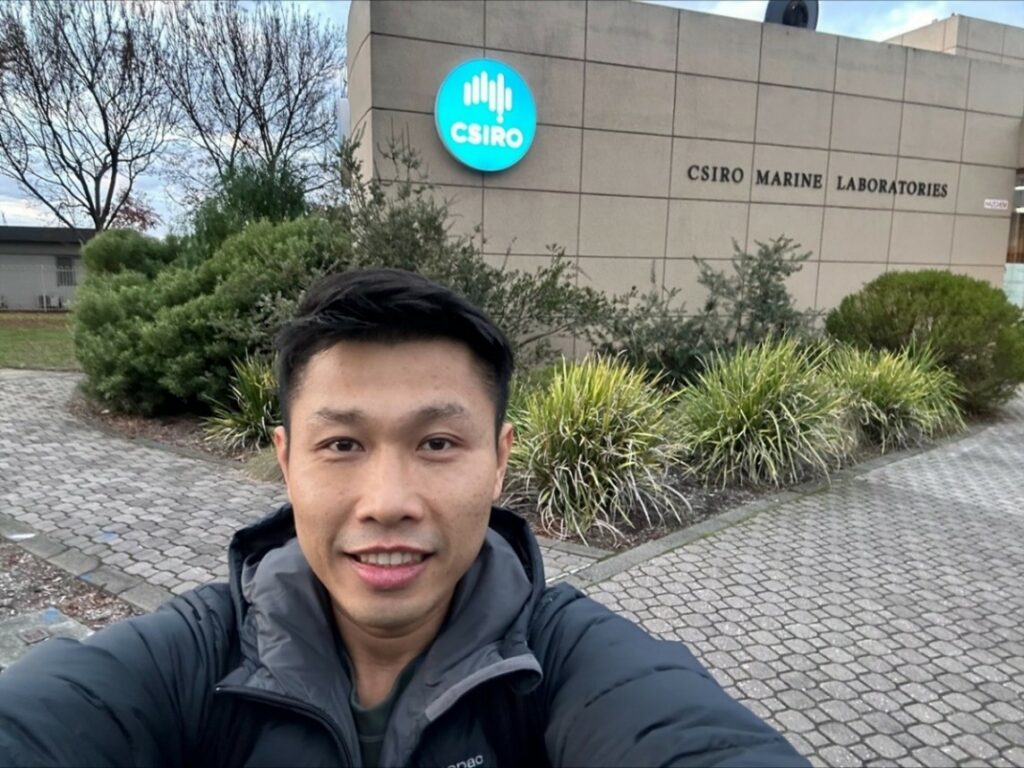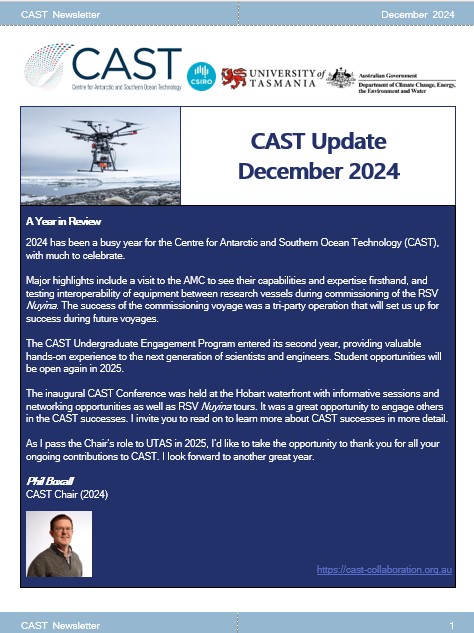
Applications are open for 2025 CSIRO-UTAS Studentships!
The CSIRO-UTAS Studentships provide high achieving University of Tasmania (UTAS) students in their final year of undergraduate study (including Honours) the opportunity to work with Australia’s national science agency, CSIRO, across a range of projects and discipline areas.
Starting your Studentship in February 2025, you will receive $11,000 to work two days a week across Semester 1 and Semester 2 (including mid-term break). All projects are located on-site at CSIRO Marine and Atmospheric Research in Hobart.
Successful applicants may also like to consider enrolling in KAA315 STEM Work Integrated Learning at UTAS in Semester 1 or Semester 2, 2025 if they wish to combine their Studentship with their studies.
Applications should be submitted by 5.00 pm, 27th October 2024.
What are the CSIRO-UTAS Studentships?
The CSIRO-UTAS Studentship program is an initiative of the Centre for Antarctic and Southern Ocean Technology (CAST). The aim of CAST is to advance Antarctic and Southern Ocean research by enabling collaborative effort in technology and engineering innovation and development, education and training, and the sharing of resources.
Previous recipients of our Studentships and information about their projects can be viewed on CAST News here.
How to Apply
To apply for a 2025 CSIRO-UTAS Studentship please send an application with the following:
- A paragraph outlining your interest in the CSIRO-UTAS Studentship program, your goals for the future, and which project(s), from the projects listed below, you wish to apply for. You may nominate up to two projects you wish to be considered for.
- Your UTAS academic transcript.
- Your Curriculum Vitae (CV).
Applications should be emailed to claire.mulhall@csiro.au by 5.00pm, 27th October 2024.
If you have any questions about the CSIRO-UTAS Studentship program, the projects, or your eligibility, please contact sm-cast_secretariat@utas.edu.au.
Shortlisted applicants will be contacted by CSIRO in early December and invited for an interview.
2025 Studentship Projects
The following projects are available in 2025. There is one placement per project.
| Project Title and Description | Discipline | Primary Supervisor and Team at CSIRO |
| 1. Processing CSIRO-AusSeabed bathymetry datasets through the AusSeabed (ASB) pipeline CSIRO’s Geophysical Survey & Mapping (GSM) Team has developed a data management pipeline that allows bathymetry data to be delivered effectively to the national AusSeabed program. The student will learn how to process bathymetry datasets (using software such as Caris) and apply/develop scripts (such as Python) to enhance the CSIRO-AusSeabed data processing pipeline. | • Hydrography / Surveying • Geospatial data management • Marine Science • Earth Science | Francisco Navidad – Geophysical Survey and Mapping |
| 2. Processing CSIRO multibeam backscatter datasets in support of future AusSeabed requirements CSIRO’s Geophysical Survey & mapping (GSM) Team has a vast repository of acquired multibeam backscatter data. These datasets are mostly in raw format, and we are seeking to develop systematic processes for the creation of voyage-related products to facilitate ease-of-use for researchers and towards the future requirements of the AusSeabed initiative. The student will learn how to process backscatter datasets (using software such as Caris and QPS FMGT) and work on developing a consistent methodology for standardised outputs. A strong interest in earth sciences (geophysical or biological) would be desirable. Basic coding in python would also be advantageous, as the candidate would work to integrate previous coding in our multibeam bathymetry pipeline processes, and ultimately assist in the ability to publish backscatter products to the AusSeabed program. | • Geospatial data management • Marine Science • Earth Science | Phil Vandenbossche – Geophysical Survey and Mapping |
| 3. Water sampler for autonomous vessel(s) Environmental DNA (eDNA) is an important and growing field for marine environments. It allows for detection and monitoring of species in a non-invasive and efficient manner. Scientists can identify a wide range of organisms without the need to directly observeor capture, assisting with observations in biodiversity, tracking of rare or endangered species, and monitoring changes in distributions due to various factor. One method to increase the ability to measure eDNA at targeted locations is to use autonomous vehicles to capture samples from specified regions that are difficult to reach with traditional methods. In this project, the student will work with the Engineering & Technology program and Sensor Prototyping Hub to develop a design (or series of designs) for capturing limited number of samples from an autonomous surface vehicle (ASV). The overall system will include fluidic layout, mechanical and electronics (control) design and assembly to capture and preserve samples, waterproofing of system components for operation on vehicle, integration to vehicle (electronics/ communication) to allow for sample capture at specified location (using existing vehicle control for navigation). The student will work with a team of engineers to complete the system design, taking ownership of the research and development of aspects within their chosen engineering discipline. | • Electronics Engineering • Mechanical Engineering • Mechatronics Engineering | Andrew Filisetti – Electronics / Mechanical Engineering |
| 4. Data processing for post-autonomous missions The autonomous marine vehicle team within the Autonomous Sensor Future Science Platform (AS FSP) are developing post-mission analysis software for autonomous vehicles. The team make use of several autonomous platforms for performing scientific observations, including gliders, autonomous underwater vehicles (AUVs) and autonomous surface vehicles (ASVs), each based on different supplier software interfaces and each vehicle possesses different sensor sets and attributes. This position will contribute to a modular design to allow standardising of data collection and management across platforms. The solution developed in this project will feature: • A user interface (UI) designed for the visualisation and manipulation of data collected by these autonomous vehicles. • Hardware to integrate various sensors into different commercial vehicles in a standardised manner. | • Software Engineering • Information Technology • Computer Science • Business Information Systems • User Interface/User Experience (UI/UX) | Hui Sheng Lim – Electronics Engineering |
| 5. Optimisation of IMU for Ocean Physics The development of commercial and recreational autonomous platforms like drones and Autonomous Underwater Vehicles (AUV) has increased exponentially over the last couple of years. These platforms rely heavily on the use of an inertial measurement unit (IMU) to determine the platform’s specific force, angular rate, and orientation. It is an electronic device that interprets data from fundamental sensors like accelerometers, gyroscopes, and magnetometers to derive movement and orientation. The student will compare the performance of a range of commercially available IMU sensors. This testing scenario and equipment will be designed by the student and may include field work at sea. The student will also develop a suite of software tools to perform IMU functionality by converting data from fundamental sensors into movement and orientation. | • Electronic Engineering • Software Engineering • Mechatronics Engineering • Mechanical Engineering | Jacques Malan – Electronics Engineering |
| 6. Development of User Interfaces for RV Investigator’s Data Acquisition Systems and Electronic Logbooks CSIRO’s Data Acquisition and Processing (DAP) Team is developing and integrating new data acquisition systems onboard in the RV Investigator. These new systems collect data in real time and will require User Interfaces (UIs) for the visualisation of this data and for administration of these systems. The student will assist in the development of these UIs by creating new features, bug fixes and unit tests. They will get to apply best software development practices by using agile methodologies, version control and code reviews. | • Software Engineering • Information Technology • Computer Science • Business Information Systems • User Interface/User Experience (UI/UX) | Kieran Sheehan – Data Acquisition and Processing |
| 7. Development of a Metadata System to provide an accessible database of instruments and sensor calibration data including tracking the RV Investigator’s current and historical instrument configurations and generating instrument metadata The student will work as an integrated member of the E&T Software team, alongside senior software developers, to contribute to the development of software systems which are used for the acquisition, visualisation, and management of data. This will include development of original features as well as bug fixes and implementing unit test cases and will include use of software development best practices with issue tracking, version control, code reviews and agile methodologies. The primary programming language is Python but could also include web UI development in React. | • Software Engineering • Information Technology • Computer Science • Business Information Systems • User Interface/User Experience (UI/UX) | Stephanie Zeliadt – Information Data Systems |
Frequently Asked Questions (FAQs)
What are the eligibility requirements?
You should be commencing the final year of an undergraduate degree offered in the College of Sciences and Engineering at UTAS in Semester 1 or Semester 2 next year.
I am commencing Honours next year. Am I eligible to apply?
Yes. If you are commencing Honours (e.g., BSc(Hons)) next year, or your Honours program is embedded in the final year of your undergraduate degree (e.g., BE(Hons)), you are eligible to apply.
I will be graduating at the end of Semester 1. Am I eligible to apply?
Applicants graduating mid-year may still be eligible. Intending applicants should contact CSIRO to discuss their preferred project(s). It may be possible, for example, for the project objectives to be reduced in scope and completed in a shorter period.
Is my degree eligible? What units should I be studying?
You must be enrolled in an undergraduate degree offered by the College of Sciences and Engineering at UTAS. There are no specific prerequisite units for the studentships, but you should be studying in an area relevant to the discipline in which the CSIRO projects are offered. The projects and discipline areas vary from year to year.
Do I need a minimum GPA?
All students are eligible to apply if they meet the eligiblity requirements. A minimum grade point average (GPA) is not required.
Do I have to enrol in KAA315?
You do not have to enrol in KAA315 STEM Work Integrated Learning to undertake a CSIRO Studentship, but it is an option you might like to consider. Contact the KAA315 Unit Coordinator, Professor Tina Acuna (tina.acuna@utas.edu.au) if you would like to know more about KAA315 and whether it can be counted towards your graduation requirements.
Are international students eligible to apply?
Yes.
Can I apply for more than one CSIRO-UTAS Studentship project?
Yes. You can nominate up to two different projects when you apply for a studentship, but if your application is successful you will only undertake one project.
When will I know the outcome of my studentship application, and if it’s successful when will I start my project at CSIRO?
CSIRO will contact shortlisted applicants by early December to discuss the project(s) they have applied for and their suitability. Successful applicants be notified before the end of the year and undergo CSIRO onboarding in January. Onboarding is mostly done online and then students are inducted to on-site during the first week of their placement. Placements commence in February.
What is the duration of the studentship and how many hours a week will I be working?
Studentships are spread approximately across the academic year, commencing in February and typically concluding in November. Normal working hours (spread as 60 days across the calendar year) apply or are as agreed by UTAS, CSIRO and the student.
What is the value of the scholarship and how am I paid?
Scholarships amounts are $AUD 11,000 in total, paid fortnightly by UTAS when you start your project (i.e., 20 x $550 payments). A living allowance and additional expenses may also be paid by CSIRO to the student where applicable to the project.
What happens if I withdraw from my degree before the end of the studentship?
You must remain enrolled in your degree at UTAS for the duration of the studentship or your scholarship payments, the studentship and access to CSIRO facilities may be terminated.
Is my scholarship taxable?
Your scholarship may be taxable.
UTAS can provide general information about scholarships and tax that may be of assistance; however, the University and CSIRO cannot advise you directly as taxation depends on individual circumstances.
The Australian Taxation Office (ATO) has an online tool to help you determine if your scholarship is taxable.
If you require further advice about taxation, please contact the ATO directly or your tax advisor.
Am I considered a CSIRO or UTAS employee?
No. Students undertaking a CSIRO-UTAS Studentship are not considered employees.



